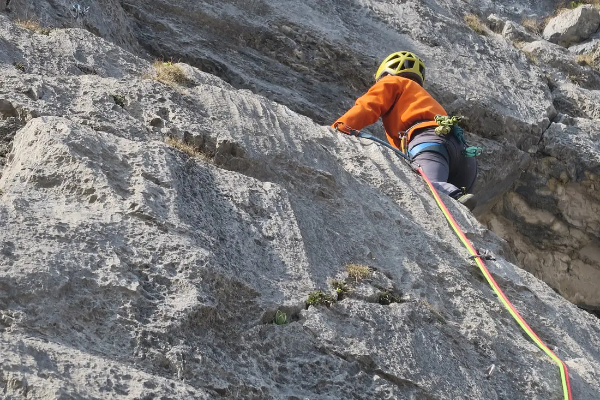Dry tooling climbing is a fascinating and challenging form of climbing that combines elements of rock climbing and ice climbing. It involves using ice tools, such as ice axes, on rock surfaces. This hybrid discipline requires skill, strength, and mental fortitude. In this comprehensive article, we will explore the origins, techniques, equipment, training, and safety aspects of dry tooling climbing.
The Origins of Dry Tooling Climbing
Dry tooling has its roots in traditional ice climbing. Climbers initially used their ice tools on rock sections to navigate between ice formations. Over time, this practice evolved into a distinct discipline. The sport gained popularity in the 1990s, particularly in Europe. Climbers sought to extend their climbing season and improve their technical skills.
Equipment for Dry Tooling Climbing
Dry tooling requires specific equipment. The primary tools are ice axes and crampons. Ice axes are designed with sharp picks and ergonomic handles. These tools provide the necessary grip and leverage on rock surfaces. Crampons, with their pointed spikes, are worn on climbing boots to enhance traction.
Other essential equipment includes:
- Helmet: Protects the head from falling debris and accidental tool strikes.
- Harness: Worn around the waist and thighs for attaching to the climbing rope.
- Rope: Dynamic ropes are preferred for their ability to absorb shock.
- Quickdraws: Used to clip the rope to anchors on the rock.
- Climbing Shoes: Specialized shoes with sticky rubber soles for better grip.
Techniques in Dry Tooling Climbing
Mastering dry tooling techniques is crucial for success. Here are some key techniques:
- Hooking: Using the pick of the ice axe to hook onto small edges and pockets on the rock.
- Figure Four: A move where the climber hooks one leg over the arm holding the tool, creating a stable platform.
- Torquing: Wedging the pick of the ice axe into a crack and twisting it to gain a secure hold.
- Footwork: Precise foot placements using crampons to maximize stability and minimize energy expenditure.
Training for Dry Tooling Climbing
Training for dry tooling involves building strength, endurance, and technique. Here are some training tips:
- Strength Training: Focus on upper body, core, and grip strength. Exercises like pull-ups, dead hangs, and core workouts are beneficial.
- Endurance Training: Incorporate cardio workouts to improve overall stamina. Climbing-specific endurance can be developed through long climbing sessions.
- Technique Drills: Practice specific dry tooling moves on training walls or outdoor routes. Repetition builds muscle memory and efficiency.
- Flexibility and Mobility: Stretch regularly to maintain flexibility, which aids in making dynamic moves and reaching holds.
See Also: What Is Belaying in Rock Climbing
Safety Considerations in Dry Tooling Climbing
Safety is paramount in dry tooling climbing. Adhering to safety protocols reduces the risk of accidents. Key safety considerations include:
- Proper Gear: Ensure all equipment is in good condition and suitable for dry tooling.
- Helmet Use: Always wear a helmet to protect against falling rocks and accidental tool impacts.
- Partner Communication: Maintain clear communication with your climbing partner. Use standard climbing commands.
- Route Assessment: Evaluate the route for potential hazards. Identify solid placements for ice tools and crampons.
- Anchor Inspection: Check anchors and protection points for stability before committing to moves.
Popular Dry Tooling Destinations
Several destinations are renowned for dry tooling climbing. Some popular spots include:
- Rjukan, Norway: Known for its extensive ice climbing routes and dry tooling opportunities.
- Ouray, Colorado, USA: Home to the Ouray Ice Park, offering a variety of dry tooling routes.
- Kandersteg, Switzerland: Features challenging dry tooling routes in the Swiss Alps.
- Lake Willoughby, Vermont, USA: Offers a mix of ice and dry tooling routes in a picturesque setting.
The Future of Dry Tooling Climbing
Dry tooling climbing continues to evolve. Advances in equipment and training techniques contribute to the sport’s growth. Competitions are gaining popularity, showcasing the skills and athleticism of top climbers. As climbers push the boundaries, new routes and challenges emerge.
Conclusion
Dry tooling climbing is a dynamic and demanding sport. It bridges the gap between rock climbing and ice climbing, offering a unique challenge. With the right equipment, techniques, and training, climbers can master this exciting discipline. Safety is crucial, and climbers must always be mindful of their surroundings and gear. Whether you’re a seasoned climber or a newcomer, dry tooling climbing offers endless opportunities for adventure and growth.
FAQ: What Is Dry Tooling Climbing
Q: What equipment do I need for dry tooling climbing?
A: You will need specialized gear, including an ice axe, crampons, a harness, and a helmet. It is important to use equipment specifically designed for dry tooling climbing.
Q: Can I use my regular climbing shoes for dry tooling?
A: No, you will need to wear specialized footwear called crampons, which are metal spikes that attach to your boots to provide better grip on the wall.
Q: How do I get started with dry tooling climbing?
A: It is recommended to take a class or hire an experienced instructor to teach you the proper techniques and safety measures. You can also find instructional videos online to help you learn the basics.
Q: Is dry tooling climbing safe?
A: As with any form of climbing, there are risks involved. However, by following proper safety measures and using the correct equipment, you can minimize the risk of injury.
Q: What are some benefits of dry tooling climbing?
A: Dry tooling climbing can improve your strength, endurance, and coordination. It also allows you to practice techniques used in ice climbing without the danger of falling into freezing water.

